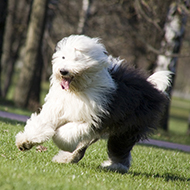Old English sheepdog at risk of extinction

The old English sheepdog became officially known as the Dulux dog in 1961.
The Kennel Club has categorised the iconic old English sheepdog as Vulnerable for the first time following a sharp fall in the popularity of the breed.
Perhaps best known as the mascot for Dulux paint, the Old English Sheepdog saw just 227 puppy registrations in 2020. The figure is the lowest recorded for the breed since 1961 and comes despite last year seeing The Kennel Club’s highest puppy registrations in 10 years.
“The Old English Sheepdog is such an historic and iconic breed, but they are rarely seen out and about over recent years, so the fact that they are now officially a vulnerable breed is very worrying,” commented Bill Lambert, a spokesperson for The Kennel Club.
“It’s likely the numbers have dwindled over the years due to a result of lifestyle changes, as they require a lot of grooming and exercise and aren’t suitable for smaller living spaces. However, it is a breed that is faithful and trustworthy with an even disposition that can make lovable family pets for the right owners.”
The Old English Sheepdog became officially known as the ‘Dulux dog’ in 1961, and subsequently saw its numbers grow. Registrations peaked at 6,000 in 1979 when it became the ninth most popular British breed.
Since then, puppy registrations have tumbled by 96 per cent, with a 28 per cent drop in the last year compared to 2019. While the breed has been on the Kennel Club’s ‘At Watch’ list for some time, this is the first time it has entered the organisation’s Vulnerable Native Breeds List.
The Kennel Club hopes the current shift in people moving out of cities into more rural areas as a result of the pandemic could mean brighter days ahead for this playful and affectionate breed.
“The nation has gone through a huge collective lifestyle change in the past year, and of course many have either become first-time dog owners or are currently looking to buy one soon," Bill continued. "With some people now deciding to move out of our cities towards more rural areas, there is hope for some of our larger and more vulnerable breeds yet.
“We have such a rich diversity of breeds in the United Kingdom, all with their own unique characteristics, so we really do urge the British public to find out more about the lesser-known breeds, especially those who are at risk of disappearing, in order to get a dog that is truly right for them.”
The Kennel Club’s Vulnerable Native Breeds list contains British and Irish native breeds which have dropped below 300 annual puppy registrations and could be at risk of disappearing altogether.
Other breeds listed on the Vulnerable list include the otterhound, Skye terrier and the bloodhound.



 The RCVS has announced a new version of its 1CPD mobile app, with enhanced features for veterinary surgeons and veterinary nurses to record their continuing professional development.
The RCVS has announced a new version of its 1CPD mobile app, with enhanced features for veterinary surgeons and veterinary nurses to record their continuing professional development.